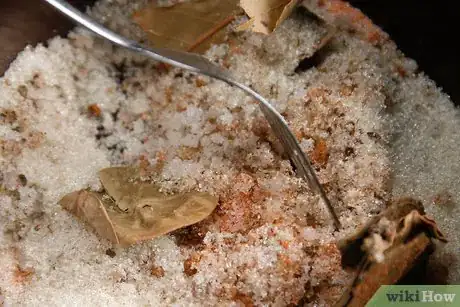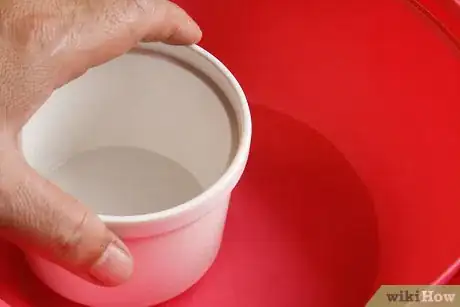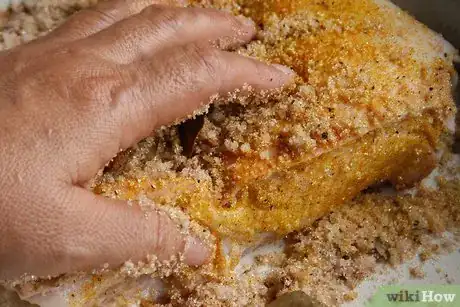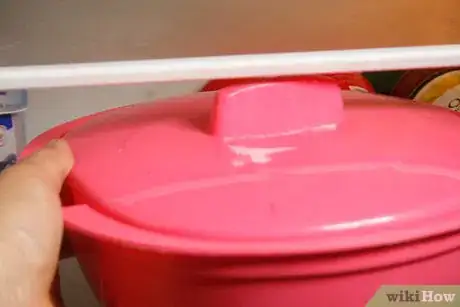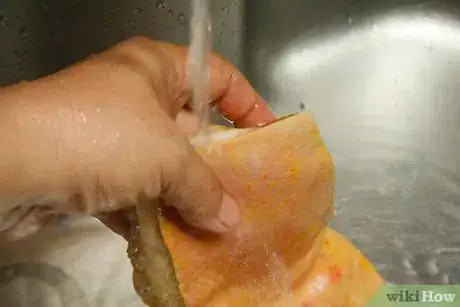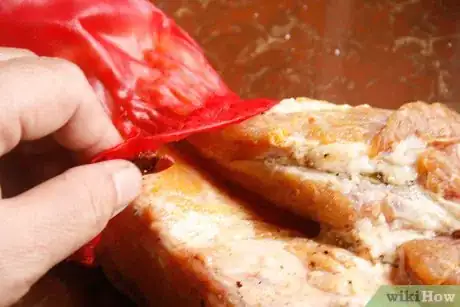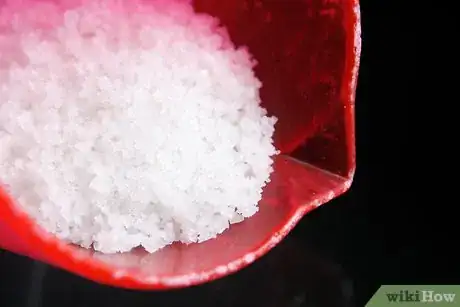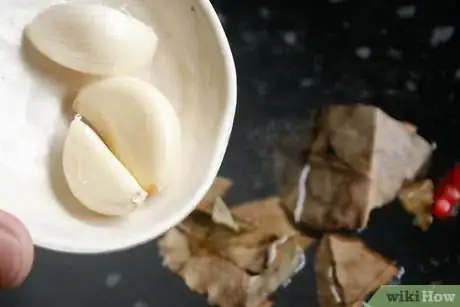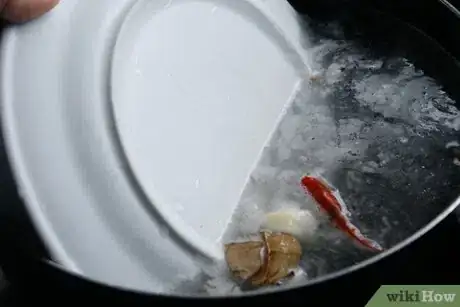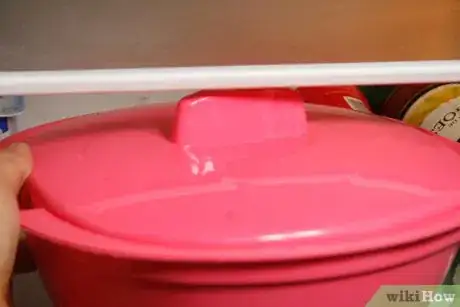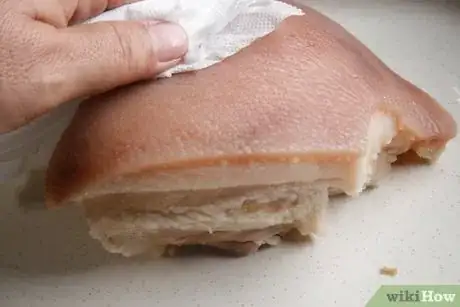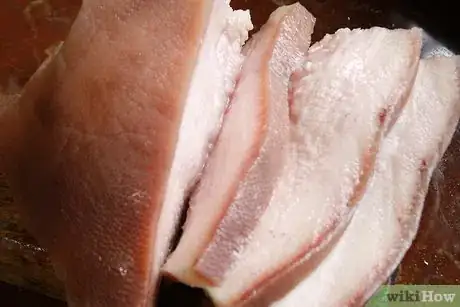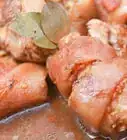This article was co-authored by wikiHow staff writer, Jessica Gibson. Jessica Gibson is a Writer and Editor who's been with wikiHow since 2014. After completing a year of art studies at the Emily Carr University in Vancouver, she graduated from Columbia College with a BA in History. Jessica also completed an MA in History from The University of Oregon in 2013.
There are 7 references cited in this article, which can be found at the bottom of the page.
This article has been viewed 176,816 times.
Learn more...
Curing your own pork is a great way to customize flavors and control the preservation process. Decide what cut of pork you'd like to cure and choose a dry rub or wet brine. Coat the pork in a dry rub containing curing salt and seasonings or submerge it in a salty seasoned brine. Leave the pork to cure for several days before finishing and heating the meat.
Ingredients
- 5 pounds (2.3 kg) pork belly
- ¼ cup (75 g) coarse kosher salt
- 2 teaspoons (11 g) pink curing salt (also called Insta-Cure or Prague Powder)
- 4 tablespoons (27.5 g) coarsely ground black pepper
- 4 bay leaves, crumbled
- 1 teaspoon (2 g) freshly grated nutmeg
- 1/4 cup (50 g) brown sugar, honey, or maple syrup
- 5 cloves of garlic, crushed
- 2 tablespoons (9 g) juniper berries, lightly crushed
- 10 sprigs fresh thyme
Makes 5 pounds (2.3 kg) of pork belly
- 2 1⁄2 gallons (9.5 l) water
- 1 cup (273 g) non-iodized salt
- 3/4 cup (150 g) sugar
- 2 bay leaves
- 2 to 3 whole peppercorns
- 1 clove
- 6 allspice berries
- 2 small dried chili peppers
- 3 garlic cloves, peeled
- 1 tablespoon (4 g) dried thyme
- 3 pounds (1.4 kg) boneless pork loin or shoulder
Makes 3 pounds (1.4 kg) of pork
Steps
Dry-Cured Pork Belly
-
1Mix the salts, pepper, bay, nutmeg, sugar, garlic, and juniper. Pour ¼ cup (75 g) of coarse kosher salt into a bowl and stir in 2 teaspoons (11 g) of pink curing salt, 4 tablespoons (27.5 g) of coarsely ground black pepper, 4 crumbled bay leaves, 1 teaspoon (2 g) of freshly grated nutmeg, 1/4 cup (50 g) of brown sugar, 5 cloves of crushed garlic, 2 tablespoons (9 g) of lightly crushed juniper berries, and 10 sprigs of fresh thyme.[3]
- If you prefer, substitute honey or maple syrup for the brown sugar.
-
2Place a ramekin in a storage container. Get out a non-reactive container that's large enough to hold the pork belly. Set a small ramekin upside down in the bottom of the container.
- Use a plastic, glass, or enamel container, but avoid metal containers since these will affect the flavor of the pork.[4]
- When you place the pork on the ramekin and the pork gives off liquid, the ramekin will keep the pork from curing in its juice.
Advertisement -
3Coat the 5 pounds (2.3 kg) pork belly with the dry rub. Place the belly on a cutting board or platter and cover it with the dry rub mixture. Use your hands to firmly rub the mixture into all sides of the pork.[5]
-
4Place the pork belly in the container and cover it. Arrange the pork belly in your storage container so it's propped up on the overturned ramekin. Put the lid on the storage container.
-
5Refrigerate and turn the pork every 2 days for 1 week. Place the container with the pork belly into a refrigerator and leave it to cure. Remove the pork from the refrigerator and flip it over once every 2 days. Return it to the refrigerator and keep flipping it every 2 days for 1 week.[6]
-
6Remove and rinse the cure off of the pork belly. After a week, take the pork belly out of the refrigerator. Rinse it with cool water so the dry rub washes away. Use paper towels to pat the cured pork belly completely dry.
-
7Place the pork belly in muslin and hang it for at least 1 week. Put the dry pork belly into a muslin bag and tie a knot at the end. Insert a hook into the knot and hang the pork belly in a cool, dry place for at least 1 week.[7]
- If you're pressed for time, you can skip this step but the flavor of the pork will be more intense the longer it cures.
-
8Slice and heat the pork belly. Cut the pork belly into slices as thick as you like and then fry, roast, broil, or grill the meat until it's completely cooked. For example, slice the pork belly into 1/4 in (0.6 cm) slices and then fry for 7 to 8 minutes to get crispy bacon.
- Refrigerate the cured pork belly that you haven't cooked. Store it in an airtight container for up to 1 week.
Brine-Cured Pork Loin or Shoulder
-
1Pour the water, sugar, and salt into a large pot. Place a nonreactive pot on the stove and pour in 2 1⁄2 gallons (9.5 l) of water. Stir in 1 cup (273 g) of non-iodized salt and 3/4 cup (150 g) of sugar until they're dissolved.[8]
-
2Stir in the bay, pepper, clove, allspice, peppers, garlic, and thyme. Lightly crush 2 bay leaves and add them to the pot along with 2 to 3 whole peppercorns, 1 clove, 6 allspice berries, 2 small dried chili peppers, 3 peeled garlic cloves, and 1 tablespoon (4 g) of dried thyme.
-
3Put the pork in the pot and weigh it down with a plate. Place 3 pounds (1.4 kg) of boneless pork loin or shoulder into the pot with the brine. Set a plate on top of the meat so it pushes the meat down.
- The pork needs to be completely submerged in the brine as it cures.[9]
-
4Cover and refrigerate the pork for 5 days. Put the lid on the pot or cover it tightly with plastic wrap. Put the pot in the refrigerator and cure the pork.
- If you'd like to cure chops or smaller cuts of pork, try curing it for only 2 to 3 days.
-
5Remove the pork and dry it completely. Remove the pot from the refrigerator and lift the pork out of the brine. Set it on a platter and use paper towels to pat it dry.
-
6Cook the pork according to your preference. If you'd like to finish the pork in the oven, put it in an oven-safe dish and roast it at 375 °F (191 °C) for about 1 hour. You can also grill the pork over medium heat for 2 1/2 to 3 hours.
- For faster cooking, slice the pork into 1/2 in (1.2 cm) chops and fry them for a few minutes on each side.
Community Q&A
-
QuestionCan you eat pork that has not been cured?
 Community AnswerYes, you can eat uncured pork. You usually cook cured pork, so the process before eating uncured pork would be similar.
Community AnswerYes, you can eat uncured pork. You usually cook cured pork, so the process before eating uncured pork would be similar. -
QuestionWhich pink curing salt is being used? #2 has both nitrite and nitrate for longer curing time, is this the one you use because of the drying time after curing?
 Community AnswerThe curing agent is the nitrite. When the meat has to be cured for a long time (e.g. more than six months -- some hams are cured for 2 to 3 years), the nitrite is used up but the salt-resistant bacteria will convert the nitrate to nitrite to continue the curing process, thus the reason for the nitrate. Remember that both nitrites and nitrates are toxic at certain levels. Use ONLY the correct doses in your cure.
Community AnswerThe curing agent is the nitrite. When the meat has to be cured for a long time (e.g. more than six months -- some hams are cured for 2 to 3 years), the nitrite is used up but the salt-resistant bacteria will convert the nitrate to nitrite to continue the curing process, thus the reason for the nitrate. Remember that both nitrites and nitrates are toxic at certain levels. Use ONLY the correct doses in your cure. -
QuestionCan I cure pork belly without curing salt?
 Community AnswerYes. You can use regular Morton's iodized salt. Leave it for 12 to 14 days, thoroughly rinse it, and hang it for another two weeks.
Community AnswerYes. You can use regular Morton's iodized salt. Leave it for 12 to 14 days, thoroughly rinse it, and hang it for another two weeks.
Things You'll Need
Dry-Cured Pork Belly
- Mixing bowl
- Spoon
- Measuring cups and spoons
- Non-reactive container with lid
- Ramekin
- Paper towels
- Cutting board or platter
- Knife
- Muslin bag
- Hook
Brine-Cured Pork Loin or Shoulder
- Large pot with lid
- Measuring cups and spoons
- Spoon
- Plate
References
- ↑ https://www.melissaguerra.com/2017/04/home-cured-pork-belly-amazing-bacon/
- ↑ https://www.splendidtable.org/recipes/brine-cured-pork
- ↑ https://kitchenwrangler.com/2017/04/home-cured-pork-belly-amazing-bacon/
- ↑ https://oldfatguy.ca/?p=6340
- ↑ https://georgiapellegrini.com/2010/03/09/food-drink/homemade-bacon/
- ↑ https://georgiapellegrini.com/2010/03/09/food-drink/homemade-bacon/
- ↑ https://www.motherearthnews.com/real-food/seasonal-recipes/dry-cured-pork-belly-zerz1511zdeh
- ↑ https://www.splendidtable.org/recipes/brine-cured-pork
- ↑ https://www.foodiewithfamily.com/homemade-maple-canadian-bacon-smoker-optional/
About This Article
To cure pork, start by mixing water, sugar, and salt in a large pot. Then, add bay, pepper, clove, allspice, garlic, and thyme to the pot. Once you've prepared the curing mixture, put the pork in the pot and weigh it down with a plate so it's completely submerged. Next, put the lid on the pot and refrigerate the pork for 5 days. After 5 days, remove the pork and pat it dry before cooking. To learn how to dry-cure pork belly, keep reading!
